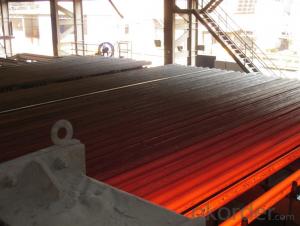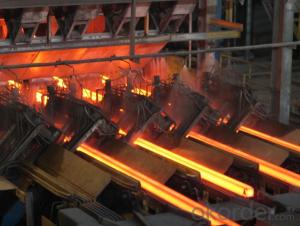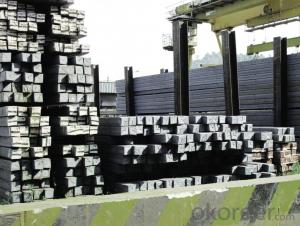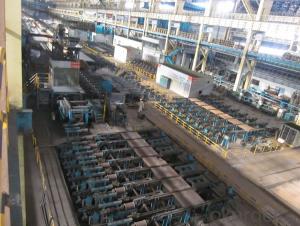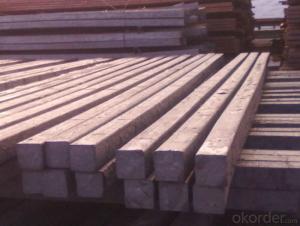Prime Q275 85mm Square Alloy Steel Billet
- Loading Port:
- Shanghai
- Payment Terms:
- TT OR LC
- Min Order Qty:
- 100 m.t.
- Supply Capability:
- 10000 m.t./month
OKorder Service Pledge
OKorder Financial Service
You Might Also Like
Structure of Prime Q275 85mm Square Alloy Steel Billet

Description of Prime Q275 85mm Square Alloy Steel Billet
1. Prepainted steel coil is coated with organic layer, which provides higher anti-corrosion property and a longer lifespan than that of galvanized or galvalume steel sheets.
2. The base metals for prepainted steel coil consist of cold rolled, HDGI Steel, electro-galvanized and hot-dip alu-zinc coated steel. The finish coats of prepainted steel coil can be classified into groups as follows: polyester, silicon modified polyesters, polyvinylidene fluoride, high-durability polyester, etc.
3. The production process has evolved from one-coating-and-one-baking to double-coating-and-double-baking, and even three-coating-and-three-baking.
4. The color of the prepainted steel coil has a very wide selection, like orange, cream-colored, dark sky blue, sea blue, bright red, brick red, ivory white, porcelain blue, etc.
5. The prepainted steel coils can also be classified into groups by their surface textures, namely regular prepainted sheets, embossed sheets and printed sheets.

Main Feature of Prime Q275 85mm Square Alloy Steel Billet
Uncoated CR steel sheet
With the features of in line with the international highest standards in demension and shape, excellent surface finish and properties, the products are mainly used in home appliance and automobile industries.
Galvanized steel sheet(include HDG and EG)
With the features of good corrosion resistance, the products are mainly used in automobile, home appliance, electronics, building and machinery manufacture industries, etc.
Precoated steel sheet
With the features of enviromental protection and good processablility, long lasting surface durability, rich in colors, the products are maily used in building, home appliance and furniture industries, etc.
Applications of Prime Q275 80mm Square Alloy Steel Billet
A. Corrugated design makes it excellent waterproof performance
B. Materials as prepainted steel sheets, galvanized steel sheets, galvalume (Al-Zn coated sheets) are available to make corrugated sheet.
C.Those material are durable, anti-corrosion in bad weather for 20-30 years based on it's Zinc(Galvanized) coating or AZ (Galvalume) coating.
D. Different shape of the sheet make it suitable for any style of buildings.
E.Easy to install, no need special tools to fix the sheet.
F.Light weight due to high strength to weight ratio of steel. Light weight means easier handling lower shipping costs, easier installation
G. Different color is availbe base on the RAL Standard make your building more beautiful.
H. We will provide the best solutions if you don't have a exact idea of the specification you want for the steel sheet based on your weather conditions, engineering structure, construction budget and so on.

Specifications of Prime Q275 85mm Square Alloy Steel Billet
Product | Billet |
Material Grade | SGCC / SGCH / DX51D+AZ, etc |
Thickness | 0.6-3.0mm |
Width | 500-1500mm |
Tolerance | Thickness: +/-0.02mm , Width:+/-2mm |
Zinc-coating | Z30-150g/m2 |
Technique | Raw material: Hot rolled steel coil --> Cold rolled_>hot dipped galvalume |
Surface | Dried, Chromated, Unoiled |
Spangle | Regular spangle , small spangle, zero spangle |
ID | 508MM 610MM |
Coil weight | 1-25MT |
Export package | Cardboard inner sleeves, Waterproof paper, galvanized steel covered and steel strip packed |
FAQ of Prime Q275 85mm Square Alloy Steel Billet
We have organized several common questions for our clients,may help you sincerely:
1. How Can I Visit There?
Our company is located in Tianjin City, China, near Beijing. You can fly to Tianjin Airport Directly. All our clients, from home or aboard, are warmly welcome to visit us!
2. How Can I Get Some Sample?
We are honored to offer you sample.
3. Why choose CNBM?
Our delivery time about 15-20days for standard sizes, if you have other requirements like hardness, quanity and width ,it is about 20-40days. But don't worry we also try our best for the delivery time ,because time longer and our cost is higher.
- Q:What is the cost of producing steel billets?
- The production cost of steel billets can vary depending on different factors, such as the quality of the raw materials used, the production process employed, and the market conditions. Typically, the cost of producing steel billets includes several components. Firstly, there is the cost of raw materials, which usually consist of iron ore, coal or coke, and other alloying elements. The prices of these materials can change due to global market dynamics and availability. Secondly, the cost of energy is a significant factor in steel billet production. This includes the cost of electricity and fuel needed for the manufacturing process, such as powering the blast furnaces or electric arc furnaces used to melt the raw materials. Thirdly, labor costs play a crucial role in the overall production cost. This includes wages for skilled and unskilled workers involved in operating the machinery, maintaining equipment, and overseeing the production process. In addition, there are indirect costs that need to be taken into account, such as expenses for machinery maintenance and repair, transportation costs for raw materials and finished products, and overhead costs related to administrative functions. It is important to note that external factors like government regulations, tariffs, and taxes can also influence the production cost of steel billets. Furthermore, market demand and competition can impact pricing strategies and ultimately affect production costs. Therefore, providing an exact cost figure for producing steel billets is challenging due to constant fluctuations. It is best to consult industry experts or steel manufacturers for the most accurate and up-to-date information on production costs.
- Q:What are the different types of steel billet extrusion processes?
- There are several different types of steel billet extrusion processes used in the manufacturing industry. These processes involve shaping a solid steel billet into a desired profile or shape by applying high pressure. 1. Direct Extrusion: This is the most common type of steel billet extrusion process. In this method, the billet is placed inside a container called a "container" or "container die." The container has a small opening called a "die" through which the billet is forced using a ram or a piston. The steel billet is pushed through the die, and the resulting shape is formed. 2. Indirect Extrusion: In this process, the container die is stationary, and the billet is pushed through the die using a punch or a ram. The billet is placed inside a hollow chamber called a "container" or "container die" with a smaller diameter opening at one end. The punch is then used to apply pressure on the billet, forcing it to flow through the die and take the shape of the desired profile. 3. Impact Extrusion: This process is similar to direct extrusion, but it involves using a punch with a specially designed shape. The punch strikes the billet with a high impact force, causing it to flow and take the shape of the die. Impact extrusion is commonly used for producing small, intricate shapes with thin walls. 4. Hydrostatic Extrusion: In this process, the billet is placed inside a sealed chamber filled with a pressurized fluid, usually oil or water. The fluid pressure is applied to the billet, forcing it to flow through the die and take the desired shape. Hydrostatic extrusion is often used for producing complex shapes with high precision. 5. Cold Extrusion: This process involves extruding the steel billet at room temperature, without the need for heating. Cold extrusion is commonly used for producing small, intricate parts with high dimensional accuracy. It is a cost-effective method that allows for the production of parts with excellent surface finish. Each of these steel billet extrusion processes has its own advantages and limitations, and the choice of process depends on factors such as the desired shape, size, material properties, and production requirements.
- Q:What are the major steel billet producing countries?
- China, India, Russia, Japan, and the United States are the key countries in the production of steel billets. China stands out as the largest producer, responsible for more than half of global output. This dominance can be attributed to its booming steel industry, which has witnessed remarkable growth in recent decades. Following China, India emerges as the second-largest producer, with its steel sector expanding rapidly. Russia, on the other hand, boasts a robust steel industry and ranks third in terms of production. Despite a decline in recent years, Japan still holds significance in the steel billet market. Lastly, the United States contributes significantly to the production of steel billets, focusing particularly on high-quality specialty steel products. These countries play a critical role in meeting the worldwide demand for steel billets, which serve as essential raw materials across various industries, including construction, automotive, and infrastructure.
- Q:What is the average cost of steel billets?
- The average cost of steel billets can vary depending on factors such as the type, quality, quantity, and market conditions. It is recommended to check with steel suppliers or conduct market research to get the most accurate and up-to-date pricing information.
- Q:Can steel billets be used in the production of railway infrastructure?
- Steel billets have the capability to be utilized in the production of railway infrastructure. These semi-finished products are commonly employed as raw materials in the manufacturing of different steel products. In the context of railway infrastructure, steel billets can undergo further processing and shaping to create various components like rails, sleepers, and fasteners. Rails, which serve as the tracks on which trains operate, are typically crafted from steel billets. These billets are heated and passed through a rolling mill to achieve the desired rail profile. The resultant rail then goes through additional processing to meet specific requirements such as strength, durability, and resistance to wear and fatigue. Similarly, steel billets can also be employed in the production of sleepers, which are the supportive structures that hold the rails in place. Sleepers are commonly made from prestressed concrete or steel, and steel billets can be used as the raw material for manufacturing steel sleepers. Furthermore, steel billets are also applicable in the production of various fasteners that are integral to railway infrastructure. These fasteners include rail clips, bolts, nuts, and washers, which are used to securely fasten rails to sleepers and other components. In summary, steel billets play a critical role in the production of railway infrastructure. They provide the essential raw materials for manufacturing rails, sleepers, and fasteners, thereby contributing to the construction and maintenance of railway tracks, bridges, and other indispensable infrastructure elements.
- Q:How are steel billets heated for rolling?
- Steel billets are heated for rolling using a process called billet heating or billet reheating. This process involves subjecting the steel billets to high temperatures to make them more malleable and easier to shape during the rolling process. There are several methods used to heat steel billets for rolling. One common method is the use of a walking beam furnace. In this method, the steel billets are placed on a walking beam conveyor, which moves them through a furnace. The furnace is heated to a specific temperature, usually between 1100 to 1250 degrees Celsius, and the billets are exposed to this heat for a predetermined amount of time. The walking beam conveyor continuously moves the billets through the furnace, ensuring uniform heating. Another method used for billet heating is the use of a rotary hearth furnace. In this method, the steel billets are placed on a rotating hearth, which is heated by burners located underneath. As the billets rotate on the hearth, they are exposed to the heat emitted by the burners, gradually heating them up to the desired temperature. Induction heating is also a popular method for billet heating. In this method, an induction coil is used to generate an alternating magnetic field. The steel billets are placed inside the coil, and the magnetic field induces electrical currents within the billets, causing them to heat up. Induction heating is known for its efficiency and precise temperature control. Once the steel billets reach the desired temperature, they are ready for the rolling process. The heated billets are then transferred to a rolling mill, where they are further processed and shaped into various forms such as bars, rods, or sheets. The heating process is crucial as it allows the steel billets to become more ductile, reducing the risk of cracking or failure during the rolling process.
- Q:What are the different types of cleaning equipment used for steel billets?
- There are several different types of cleaning equipment that are commonly used for steel billets. These include: 1. Shot blasting machines: Shot blasting is a process that involves propelling small metal or mineral particles at high speed onto the surface of the steel billets. This helps to remove any rust, scale, or other contaminants, leaving the surface clean and smooth. 2. Ultrasonic cleaners: Ultrasonic cleaning involves the use of high-frequency sound waves to agitate a cleaning solution. This helps to remove dirt, oil, and other contaminants from the surface of the steel billets. Ultrasonic cleaners are particularly effective for removing stubborn or hard-to-reach contaminants. 3. Acid pickling tanks: Acid pickling is a process that involves immersing the steel billets in a tank of acidic solution. The acid helps to dissolve any rust, scale, or other contaminants on the surface of the billets. After pickling, the billets are usually rinsed and then dried. 4. Power washers: Power washers, also known as pressure washers, use a high-pressure spray of water to remove dirt, oil, and other contaminants from the surface of the steel billets. This is a particularly effective method for cleaning larger or heavier billets. 5. Mechanical cleaning brushes: Mechanical cleaning brushes, such as wire brushes or abrasive pads, are often used to manually scrub the surface of the steel billets. This helps to remove any loose dirt, rust, or scale. Mechanical cleaning brushes are typically used in conjunction with other cleaning methods. Overall, the choice of cleaning equipment for steel billets depends on factors such as the extent and type of contaminants present, the desired level of cleanliness, and the size and shape of the billets. Different combinations of these cleaning methods may be used to achieve the desired result.
- Q:What are the physical properties of steel billets?
- Steel billets possess various physical properties that render them highly suitable for a multitude of industrial applications. Primarily, they exhibit a remarkable strength-to-weight ratio, ensuring impeccable structural integrity and the ability to endure heavy loads without deformation or breakage. Another significant physical attribute of steel billets lies in their hardness. Steel is renowned for its hardness, which grants it resistance against wear and tear. Consequently, steel billets prove to be ideal for sectors where durability and long-term performance are of utmost importance, such as construction, automotive, and machinery industries. Furthermore, steel billets boast a lofty melting point, enabling them to withstand extreme heat without deformation or liquefaction. This trait proves indispensable in applications involving high temperatures, such as the manufacturing of tools, machinery, and equipment within the aerospace and energy sectors. Additionally, steel billets exhibit exceptional ductility and malleability, facilitating their effortless manipulation into diverse structures and products. This adaptability makes steel billets highly versatile and amenable to various manufacturing processes, including rolling, forging, and extrusion. Moreover, steel billets demonstrate commendable electrical and thermal conductivity, rendering them suitable for applications that necessitate efficient heat transfer and electrical conduction. These properties hold particular value in the production of electrical wiring, power transmission lines, and heat transfer equipment. In conclusion, steel billets possess key physical properties encompassing high strength, hardness, melting point, ductility, malleability, and conductivity. These attributes enable their utilization across a wide range of industries and applications, where their exceptional performance and reliability are indispensable.
- Q:What are the main factors affecting the machinability of steel billets?
- The machinability of steel billets, which refers to the ease with which they can be cut and shaped by machining processes, is influenced by several key factors. These factors include the composition of the steel, its microstructure, the presence of impurities or inclusions, and the mechanical properties of the material. The composition of the steel plays a crucial role in determining its machinability. Elements such as carbon, manganese, sulfur, and phosphorus can significantly affect the cutting performance. For instance, higher carbon content can increase hardness, making the steel more difficult to machine. On the other hand, manganese can improve machinability by enhancing the formation of a favorable microstructure. The microstructure of the steel, which is influenced by factors such as heat treatment and alloying elements, also affects machinability. Fine-grained steels with a homogeneous microstructure are generally easier to machine than coarse-grained ones. Additionally, the presence of alloying elements like chromium or molybdenum can improve machinability by enhancing the material's hardness and wear resistance. Impurities or inclusions in the steel, such as non-metallic particles or oxides, can have a detrimental effect on machinability. These impurities can cause tool wear, surface defects, and poor chip formation during machining. Therefore, the level of impurities in the steel should be minimized through careful production and refining processes. Furthermore, the mechanical properties of the steel, including its hardness, strength, and ductility, influence machinability. High-strength steels are typically more challenging to machine due to their increased hardness, which requires more cutting force. Ductility is also crucial as it affects the ability of the steel to form chips during machining. A balance between hardness and ductility is desirable for optimal machinability. In conclusion, the machinability of steel billets is determined by various factors, including composition, microstructure, impurities, and mechanical properties. Understanding and controlling these factors is essential for ensuring efficient and effective machining processes.
- Q:How are steel billets used in the production of transmission components?
- In the production of transmission components, steel billets are indispensable raw materials. These semi-finished products are typically obtained through the casting process and have a rectangular or square shape with a larger cross-sectional area compared to the final product. To shape the steel billets into the desired forms, a series of processes such as forging, rolling, or extrusion are employed. Each of these processes aims to transform the steel billets into specific shapes and sizes required for transmission components like gears, shafts, bearings, and housings. Forging is a widely used method for shaping steel billets. It involves heating the billet and using mechanical force to deform it into the desired shape, thereby enhancing the strength and durability of the transmission components. Rolling, on the other hand, gradually reduces the cross-sectional area of the steel billets by passing them through a series of rollers. This process helps achieve the desired shape and dimensions of the components. In certain cases, extrusion is employed to produce complex shapes. This process involves forcing the steel billets through a die to obtain the desired form, allowing for the production of intricate transmission components like splined shafts or valves. After shaping the steel billets into the required forms, further machining processes such as cutting, drilling, and grinding are carried out to achieve the final specifications. These components are then heat-treated and coated to enhance their strength, durability, and resistance to corrosion. In summary, steel billets play a crucial role in the production of transmission components as they provide a versatile and reliable raw material that can be shaped into various forms. They ensure that the transmission components possess the necessary strength, durability, and precision required for efficient and reliable operation in vehicles and machinery.
1. Manufacturer Overview |
|
|---|---|
| Location | |
| Year Established | |
| Annual Output Value | |
| Main Markets | |
| Company Certifications | |
2. Manufacturer Certificates |
|
|---|---|
| a) Certification Name | |
| Range | |
| Reference | |
| Validity Period | |
3. Manufacturer Capability |
|
|---|---|
| a)Trade Capacity | |
| Nearest Port | |
| Export Percentage | |
| No.of Employees in Trade Department | |
| Language Spoken: | |
| b)Factory Information | |
| Factory Size: | |
| No. of Production Lines | |
| Contract Manufacturing | |
| Product Price Range | |
Send your message to us
Prime Q275 85mm Square Alloy Steel Billet
- Loading Port:
- Shanghai
- Payment Terms:
- TT OR LC
- Min Order Qty:
- 100 m.t.
- Supply Capability:
- 10000 m.t./month
OKorder Service Pledge
OKorder Financial Service
Similar products
New products
Hot products
Related keywords
